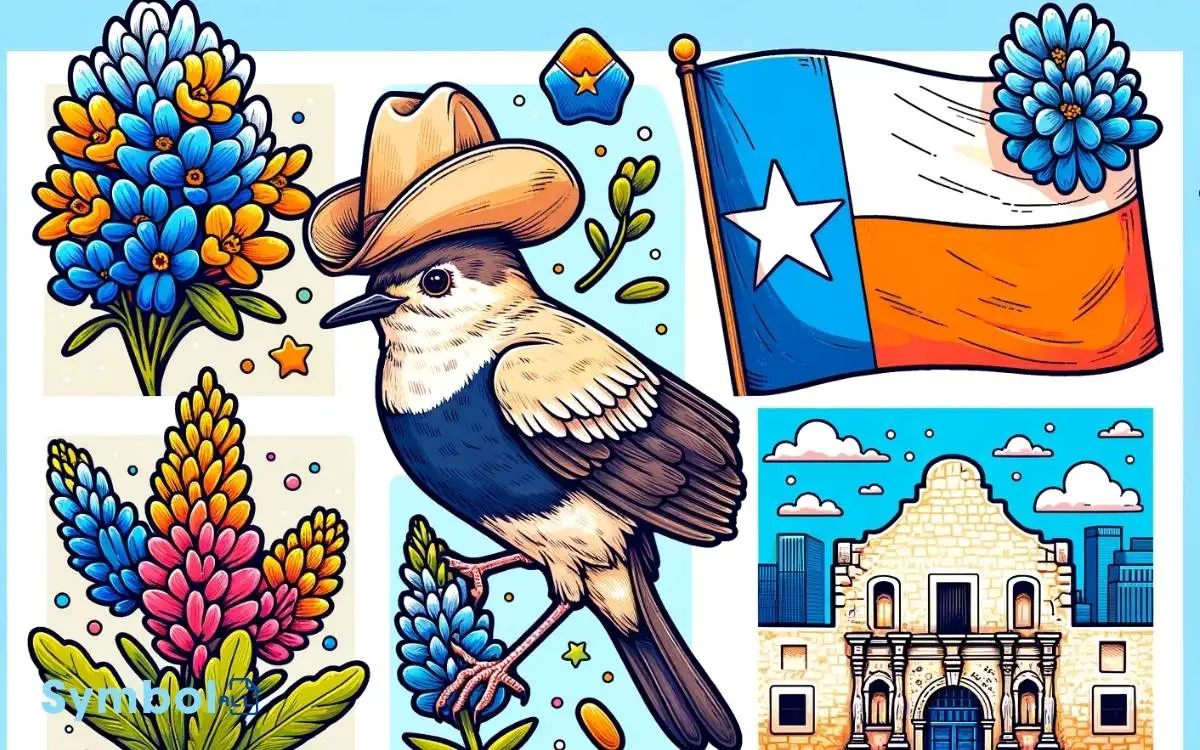Coloring Pages for Texas Symbols: Find Out Here!
Imagine immersing yourself in the spirit of Texas through art! You can start with coloring pages featuring Texas’ pride, like the Lone Star Flag, or the serene beauty of Bluebonnets.
Don’t miss out on drawing the Texas Longhorn, a symbol of resilience, or the melodious Mockingbird.
Add some fun by coloring the quirky Armadillo, or delve into history with the Alamo Mission scenes. Ever seen the elegance of pecan tree leaves changing colors?
Here’s your chance! Whether it’s cowboy boots, hats, or the excitement of rodeo scenes, you’re in for a vibrant exploration.
And who knows? You might find yourself learning new fascinating facts about Texas symbols along the way.

Key Takeaway
The Lone Star Flag
The Lone Star Flag, a symbol of Texas’ independence and pride, embodies the state’s rich history and spirit of resilience. As you prepare your coloring pages, remember the flag’s distinctive design.
It features a single white star on a blue vertical stripe, flanked by horizontal stripes of white and red. This star represents all of Texas and stands for unity as one for God, State, and Country.
The blue stripe signifies loyalty, while the white and red stripes symbolize purity and bravery, respectively.
State Flower: Bluebonnet
Next up on your coloring adventure is the state flower of Texas: the Bluebonnet. You’ll explore where these vibrant flowers bloom across the state, what conditions they thrive in, and the rich symbolism they hold.
Get your blues and greens ready as we bring these iconic blossoms to life on your page.
Bluebonnet Growth Regions
Bluebonnets flourish across various regions in Texas, painting the landscape with their vibrant blue hues each spring.
You’ll find these iconic flowers blanketing hills, valleys, and roadsides, especially in the Texas Hill Country, Central Texas, and South Texas plains.
These areas provide the perfect backdrop for bluebonnets to thrive, creating breathtaking views that attract visitors from all around.
The Texas Hill Country, in particular, is renowned for its extensive fields of bluebonnets, often paired with other wildflowers, offering a kaleidoscope of colors. While bluebonnets are widespread, they’re not just confined to rural areas.
They’ve also adapted to urban settings, adding a splash of color to city parks and green spaces. Their adaptability and resilience make bluebonnets a beloved symbol of Texas pride and heritage.
Ideal Planting Conditions
For successful bluebonnet cultivation, you’ll need well-drained soil and full sun exposure to mimic their natural Texas habitats.
Here are a few key points to remember when planting these iconic flowers:
- Essential well-drained soil; they don’t thrive in waterlogged conditions.
- Guarantee the healthiest growth and bloom.
- Slightly alkaline soil with a pH between 6.5 and 7.5 is ideal.
- Minimal fertilization is recommended as bluebonnets are adapted to the nutrient-poor, rocky soils of Texas.
Symbolic Meanings Explained
While the bluebonnet stands as a symbol of Texas pride and beauty, it also embodies deeper meanings of resilience and unity that resonate with Texans far and wide.
This vibrant flower doesn’t just capture the eye with its stunning blue hue; it tells a story of survival, thriving in the unpredictable Texas climate. Its ability to flourish amidst harsh conditions serves as a metaphor for the enduring spirit of the state’s people.
Rooted in rich soil, the bluebonnet’s presence across vast fields symbolizes Texans’ widespread solidarity and collective identity. It’s not just a flower; it’s a reminder of strength, perseverance, and the shared bond that ties every Texan together.
As you color in its delicate petals, remember what this iconic bloom represents.
The Texas Longhorn
Next up, let’s turn our focus to the iconic Texas Longhorn, a symbol that’s as rich in history as it’s in appearance.
You’ll get a quick overview of its storied past, ensuring your coloring not only looks great but is historically accurate too.
Plus, I’ll share some vibrant coloring tips and ideas to bring your Texas Longhorn pages to life with authenticity and creativity.
Longhorn History Overview
Did you know the Texas Longhorn, an iconic symbol of the Lone Star State, traces its origins back to the late 1400s when they were first brought over by Spanish explorers?
This breed hasn’t just survived but thrived, becoming a symbol of Texan resilience and independence.
Here’s why the Longhorn is so fascinating:
- Survival: Adapted to the harsh Texas environment, showcasing remarkable resilience.
- History: Integral to the development of the Texan cattle industry.
- Symbolism: Represents the rugged independence of Texas.
- Legacy: Protected as a part of Texas heritage.
Understanding the Longhorn’s journey gives you a glimpse into Texas’s rich history, making your coloring experience not just fun but educational too.
Coloring Tips & Ideas
As you immerse yourself in coloring the Texas Longhorn, remember to choose hues that reflect its rugged resilience and the vibrant history of Texas.
The Longhorn isn’t just any cattle; it’s a symbol of strength, independence, and the untamed spirit of the Lone Star State.
Start with earthy tones like burnt sienna or raw umber for its iconic hide, capturing the essence of the Texan landscape.
Don’t shy away from adding splashes of brighter colors to highlight its unique markings and the dynamic shades found in its natural habitat.
Experiment with textures to give your Longhorn a lifelike appearance, blending crayons, markers, or colored pencils for depth.
Your artwork won’t only celebrate this majestic animal but also pay homage to Texas’s rich heritage.
State Bird: Mockingbird
The mockingbird, designated as the state bird of Texas, is renowned for its melodious singing and ability to mimic the songs of other birds.
When you’re coloring a mockingbird, remember, you’re not just filling in any bird; you’re bringing to life a symbol of Texas pride and natural beauty.
- Distinctive Appearance: Look for its long legs, gray body, and white wing patches.
- Variety of Poses: Whether perched or in flight, capture its elegance.
- Musical Notes: Add musical notes around it to symbolize its singing prowess.
- Natural Habitat: Consider a background of Texas landscapes to place it in its natural setting.
Coloring a mockingbird isn’t just an activity; it’s an opportunity to connect with Texas’s rich natural heritage. Grab your crayons and let your creativity soar with the state bird’s song!
The Armadillo
Diving into the world of Texas symbols, let’s explore the armadillo, a unique creature that embodies the resilient spirit of the Lone Star State.
Known for its distinctive armored shell, the armadillo is a fascinating subject for coloring and learning.
This nocturnal mammal, primarily found in the Americas, especially in Texas, symbolizes adaptability and protection.
| Feature | Description |
|---|---|
| Habitat | Primarily found in warm, moist environments |
| Diet | Insects, small reptiles, and plants |
| Behavior | Solitary, mainly nocturnal |
| Conservation | Not currently endangered |
| Symbolism | Resilience, protection |
As you color the armadillo, think about its role in Texas’s natural heritage and how its characteristics reflect the state’s culture.
Pecan Tree Leaves
Shifting our focus to another representation of Texas, let’s explore the pecan tree leaves, an important component of the state’s official tree.
These leaves aren’t just a part of nature; they’re a symbol of Texas’ natural beauty and agricultural abundance.
When you’re coloring them, consider:
- Their elongated shape, typically ranging from 12 to 20 inches long.
- The zigzag pattern of the leaflets, which usually number between 9 to 17 per leaf.
- Their rich green color, turning to a golden hue in fall.
- The smooth texture of the leaf surface, offering a unique coloring experience.
Paying attention to these details not only enriches your coloring page but also deepens your appreciation for Texas’ natural heritage. Enjoy bringing the pecan tree leaves to life with your creativity!
Cowboy Boots and Hat
Stepping into the world of Texas symbols, you’ll find cowboy boots and hat not just as attire, but as iconic representations of the state’s rich culture and history.
These items are more than just fashion; they’re a declaration to the enduring spirit of the Texas cowboy.
Cowboy boots, with their distinctive tall leather shafts and high heels, are designed for riding. They’re both functional and stylish, a symbol of rugged individualism.
The cowboy hat, with its wide brim, serves to protect from the sun’s harsh rays, a necessity in the Texas heat. Together, they embody the essence of Texas pride and tradition.
When you color these symbols, you’re not just filling in lines; you’re connecting with a piece of American heritage.
The Alamo Mission
Moving on from cowboy boots and hats, let’s explore The Alamo Mission, a symbol that’s deeply rooted in Texas history.
You’ll learn about its pivotal role in the fight for independence and how it stands today as a demonstration to resilience and freedom.
This segment will guide you through the Alamo’s past and its lasting significance in the heart of Texans.
Alamo Mission History
The Alamo Mission, pivotal in Texas’s fight for independence from Mexico, stands as a symbol of resilience and bravery.
Originally established as a mission in the 18th century, it later became a fortress known for the famous 1836 Battle of the Alamo.
- Established: Originally founded in the 1700s for Spanish missionaries.
- Transformation: Evolved from a mission to a critical military garrison.
- The Battle of 1836: A pivotal 13-day siege that became a symbol of resistance.
- Heroes: Davy Crockett, William B. Travis, and James Bowie, among others, fought valiantly.
This historical site reminds us of the courage and sacrifice that shaped Texas. It’s not just a building; it’s a tribute to the spirit of those who fought for their beliefs.
Symbolic Meaning Today
As we explore the enduring legacy of the Alamo Mission, it’s clear that its symbolic significance continues to resonate deeply in the hearts of Texans today. It stands as a proof of bravery, sacrifice, and the unyielding spirit of those who fought for Texas’ independence.
This historic site not only commemorates a pivotal battle but also serves as a reminder of the resilience and unity that define the Texan identity.
| Aspect | Significance | Impact on Texans |
|---|---|---|
| Bravery | Emblem of courage | Inspires resilience |
| Sacrifice | Symbol of ultimate devotion | Fosters state pride |
| Independence | Reminder of fought freedom | Encourages unity |
| Historical Site | Preservation of heritage | Connects past and present |
| Educational | Learning from history | Promotes awareness |
State Seal of Texas
Plunge into the rich history and symbolism of Texas by coloring the State Seal, which encapsulates the state’s pride and heritage.
This emblem isn’t just a piece of art; it’s a narrative canvas, displaying Texas’s identity and values. As you fill in the colors, consider the depth and significance each element represents.
- Lone Star: A symbol of Texas’s independence and unity.
- Live Oak and Olive Branch: Representing peace and strength, essential values for Texans.
- “The State of Texas”: A bold declaration of identity.
- 1824: Referencing the year significant to Texas’s journey towards autonomy.
Coloring the State Seal of Texas isn’t just an activity; it’s an immersive experience into the state’s soul, teaching you about its resilience, independence, and the enduring spirit of its people.
Texas Chili Bowl
Moving from the historical emblems of Texas, let’s now savor a taste of its rich culinary tradition with the Texas Chili Bowl, a dish that embodies the state’s robust flavors and zest for life.
This isn’t just any chili. It’s a heartwarming concoction, steeped in tradition, that forgoes beans in favor of a meaty, spiced medley.
Imagine tender chunks of beef slow-cooked with chili peppers, onions, and a blend of spices that’ll tickle your taste buds.
It’s a bowl of comfort that mirrors the Texan spirit—bold, straightforward, and inviting. Whether you’re a local or a visitor, indulging in a Texas Chili Bowl is like embracing the Lone Star State’s warmth and hospitality.
Rodeo Scenes
Capture the excitement of Texas rodeos, where cowboys and cowgirls showcase their skills in a thrilling display of tradition and athleticism.
Rodeo scenes offer a glimpse into a world where skill, courage, and the spirit of the West come alive.
Coloring these scenes can immerse you in the heart of Texas culture, allowing you to explore:
- The dynamic action of bull riding, where riders aim to stay mounted on a bucking bull.
- Barrel racing, highlighting the speed and agility of both horse and rider.
- Team roping, demonstrating the importance of cooperation and timing.
- The elegance of saddle bronc riding, a test of balance and technique.
Dive into these coloring pages to experience the energy and passion of Texas rodeos, celebrating a rich heritage that continues to inspire.
Conclusion
So, you’ve journeyed through the wilds of Texas, from the vibrant bluebonnets to the stoic Longhorn, all without leaving your coloring table.
You’ve traversed historical battlegrounds, encountered the quirky armadillo, and even dished out your own Texas Chili Bowl—all with the stroke of your crayons.
Who knew embracing the spirit of the Lone Star State could be as simple as coloring inside (or let’s be honest, sometimes outside) the lines? Y’all come back now, armed with markers, for another artistic rodeo!






